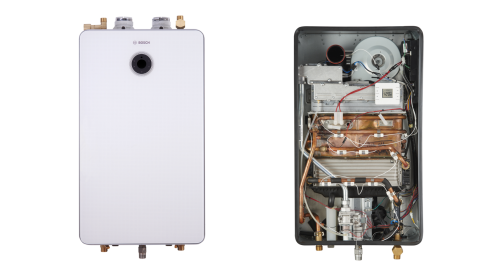In my 20-plus years in construction, I’ve built or remodeled homes with every imaginable plumbing system. Products have come and gone, but these days CPVC, copper, and PEX are the three main choices.
Home Innovation Research Labs—whose Builder Practices and Consumer Practices reports have tracked the plumbing and pipe market in new homes for almost 20 years—says that copper has fallen from the dominant position and is now a distant third. On the other hand, PEX has rapidly grown from the third position to leading the market.
“Two decades ago, CPVC was at the No. 2 position and has generally [stayed] there with only some minor growth along the way,” Home Innovation says.
With partial plumbing replacements or lines to new fixtures, CPVC is on a moderate decline, with PEX picking up the lost share. Copper and galvanized steel shares are fairly flat.
But plumbing installations in existing homes—as remodeling projects or wholehouse water pipe replacements—tell a different story. “Not surprisingly, CPVC is the most popular water pipe for both partial and whole-home replacements,” Home Innovation says. Market share and growth/decline trajectories vary considerably depending on whether it was a whole-house or partial-plumbing installation, the group adds.
Market share notwithstanding, there are pros and cons of each system, so let’s take a look at each one.
A well-known material, copper has a long track record of success. It won’t break down in the sun, has antimicrobial properties, and can be leak-free for decades. After the Flint, Mich., water crisis, the city replaced residential pipes with copper. Photo courtesy of the Copper Development Association.
Copper
This is the oldest pipe system on the market. A natural material that won’t break down in the sun if left exposed, copper has a very reliable track record. The fittings are soldered-installed and, once pressure-tested, will be leak-free for decades.
Copper also has natural bacteria-fighting properties, but its best attribute is its track record of success. I’ve heard builders say that even after a zombie apocalypse, you’ll still find 1/2-inch copper pipe and fi ttings at the mom-and-pop hardware store in Nowheresville, USA. I have several builder friends who swear by copper and will never choose another system.
About the only reason I ever see copper failure is from freezing. The pipe expands slightly when water freezes inside and will have a catastrophic split that dumps water into a basement or crawlspace.
The new kid on the block, cross-linked polyethylene (or PEX) has grown to become the leading plumbing system in new construction. Photo courtesy of Risinger & Co.
PEX
Compared with copper, PEX is a new system. Hitting the European market in 1972 under the brand name Wirsbo (now Uponor), PEX stands for cross-linked polyethylene and comes in several varieties: A, B, and C. These designations aren’t grades of pipe but instead refer to manufacturing processes and pipe characteristics.
PEX-A is the most flexible of the three and also the costliest. It uses expansion fi ttings where a cone-shaped pipe expands and then contracts over a barbed fi tting. PEX-B and C use crimped fittings, are generally less fl exible, and also cost a bit less.
One big advantage of PEX is its fl exibility. A “home-run” system, PEX can run long distances and bend (though not a sharp 90 degrees) to eliminate connections behind the walls. In theory, this should reduce the potential for joint failures and can reduce pipe turbulence from the 90-degree elbow fittings. In my testing, I’ve found that fl exibility in the pipe allows it to stretch when frozen without bursting (mainly PEX-A pipe).
Another advantage of PEX is price. It’s typically much lower in cost than copper, which is a commodity material that fluctuates with market demand. Plus, plumbers typically install PEX faster than copper with soldered fitings.
PEX uses several fitting types, but I like PEX-A’s expansion fitting. I’ve been using PEX as my primary plumbing system for the last 15 years, and I’ve had good success with the crimp fittings, only recently switching to expansion fi ttings.
In my research, PEX has some susceptibility to long-term damage from high chlorine in the water supply, which could make the pipes brittle. I believe this risk is low and wouldn’t affect the pipes for 50-plus years, but it needs to be factored into your decision if you’re in a high-chlorine water area. You may consider a wholehouse filter to remove the excess chlorine prior to installing PEX piping. Lastly, PEX isn’t UV stable for longer than 30 days, so don’t leave pipes in the sun for long.
CPVC, or chlorinated polyvinyl chloride, is a yellowish plastic polymer that won’t corrode as easily as copper pipes. The industry claims the system generally requires about 25 percent less time to install than copper. But it has a higher thermal expansion coeffi cient and it moves with changes in temperature. Photo courtesy of FlowGuard Gold.
CPVC
An offshoot of standard PVC (which isn’t approved for water distribution in a home), CPVC looks and installs similarly to PVC. I re-piped my house with CPVC about 15 years ago and loved how easy it was to use. I believe that some new homes are getting CPVC plumbing installed, but I mostly see it used as a retrofit plumbing system.
CPVC has several advantages. It’s lightweight, flexible (less water hammer), and affordable. It requires only a cutter, reamer, and solvent. The product also has excellent resistance to chemicals, abrasion, UV rays, and concrete.
But CPVC is almost as labor intensive to install as copper because of all the fittings. It also has a higher thermal expansion coefficient, which means it moves with changes in temperature.
Photo courtesy of FlowGuard Gold
"CPVC has several advantages: It’s lightweight, flexible (less water hammer), and affordable, and requires only a cutter, reamer, and solvent." —Matt Risinger, custom builder
PTC
Recently, the industry has seen the emergence of push-to-connect (PTC) products. These don’t constitute a plumbing system but are a different type of joint connection that works with copper, PEX, and CPVC. Instead of glue, PTC fittings simply push onto a cleanly cut pipe to create a watertight connection using an internal rubber gasket and a ring of teeth to keep the connection from backing off the pipe.
Invented about 15 years ago, PTC initially took off for emergency and repair situations. I remember seeing it for the first time seven or eight years ago and thinking it would allow me to shut down the kitchen of a house I’m about to remodel without calling the plumber.
But PTC manufacturers are now pushing for adoption in new builds. At $5 to $10 each, these fi ttings tend to be expensive, but labor savings may make up for the cost. We aren’t filling new openings in the trades as fast as older plumbers are retiring, so PTC may appeal to plumbing companies.
I did some testing on PTC connections and found them to be very high quality but with one Achilles’ heel: freeze issues. If the water inside the pipe freezes, the expansion tends to push off the connections. Because of this, I wouldn’t use PTC in a crawlspace or for exterior hose bib connections.
You should check with local plumbing codes to see if these connections are approved in your jurisdiction for use inside a wall. I’d hate to see you plumb a whole house and then fi nd out the local inspector has a problem with PTC.
PTC fittings are easy to use, but I’m not sure if I’m ready to use them in a new home. I may consider them for a remodeling project, but I’d like to see a multi-decade track record of success before I opt to use them for new builds. I can see a place for the system among production builders, and I do think it will gain traction—slowly.
This story first appeared in the July/August issue of PRODUCTS magazine. See the print version here.
















